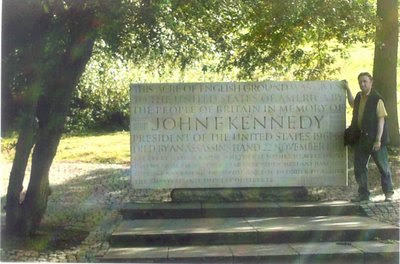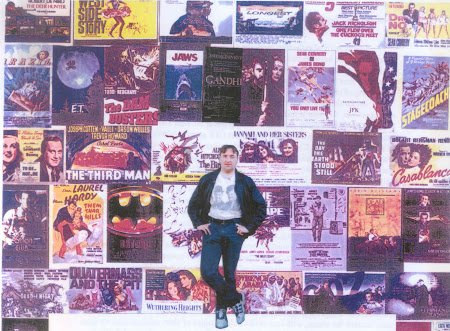
Most people who lived through it can remember exactly where they were and what they were doing on 22nd November 1963 when they first heard the news that President Kennedy had been assassinated. For my mother, it was at "The Eight Bells" in Putney where the news was revealed on a television set inside the pub. My father was a conductor on the buses when he overheard the news. It is a moment as pivotal in history as 11th September 2001 was for a later generation when the World Trade Centre was destroyed.
Oliver Stone was a budding stockbroker (chronicled in his semi-autobiographical Wall Street) at the time of 22nd November 1963, but he like everyone else, especially in America, felt the depth of anguish and heartbreak at the loss of arguably their greatest President. It is this passion which fuels his brilliant assassination conspiracy drama JFK, highly speculative for the most part, but all based on factual incidents witnessed by a variety of sources.
The one undeniable incident of the whole sad story is of course the assassination itself, on Dealey Plaza in Texas, which, the media were quick to tell the public at the time, was committed by Lee Harvey Oswald. The subsequent assassination of Oswald himself, by Jack Ruby, left a whole load of questions unanswered before anyone even thought to ask them - and set in motion over 40 years of conspiracy speculation - about Oswald's part in the overall plot to kill Kennedy, which surely could not have been his alone, especially as the results were so fatally successful.
Oswald, as played uncannily by Gary Oldman, is depicted as an occasionally aggressive but largely
 bewildered "patsy", and is just one of many star names whose appearance in the film is of secondary importance to that of the subject itself: there is the chief suspect put on trial by Jim Garrison, Clay Shaw (Tommy Lee Jones), in addition to other dubious witnesses such as David Ferrie (Joe Pesci), Willie O'Keefe (Kevin Bacon), shady lawyer Dean Andrews (an unusually edgy John Candy), and notably a mysterious Washington insider named "X" (aka. Colonel L. Fletcher Prouty) played with dignified relish by Donald Sutherland. Even veterans like Walter Matthau and Jack Lemmon (in separate scenes) and Ed Asner have cameos, giving the film an added respectability from the supposedly stubborn older generation. All of these actors deliver characteristic, ready-to-order performances which are woven brilliantly by Stone into the narrative of history.
bewildered "patsy", and is just one of many star names whose appearance in the film is of secondary importance to that of the subject itself: there is the chief suspect put on trial by Jim Garrison, Clay Shaw (Tommy Lee Jones), in addition to other dubious witnesses such as David Ferrie (Joe Pesci), Willie O'Keefe (Kevin Bacon), shady lawyer Dean Andrews (an unusually edgy John Candy), and notably a mysterious Washington insider named "X" (aka. Colonel L. Fletcher Prouty) played with dignified relish by Donald Sutherland. Even veterans like Walter Matthau and Jack Lemmon (in separate scenes) and Ed Asner have cameos, giving the film an added respectability from the supposedly stubborn older generation. All of these actors deliver characteristic, ready-to-order performances which are woven brilliantly by Stone into the narrative of history.Indeed, the secret of the film's (artistic) success is the brilliant intercutting and cross-flowing narrative of the editing of real/fake and colour/black-and-white footage, by Joe Hutshing and Pietro Scalia, which makes a 3 hour+ film incredibly gripping - and led in some ways to something of a Hollywood trend for long films not to have (or in in this case not need) an intermission. Be it not forgotten also, the rhythm of the film is orchestrated by an impassioned and typically fine score by the ever adaptable John Williams.
 The only fundamental criticism I would have is that the film whitewashes John F. Kennedy, but the story is not really about him anyway. Kennedy was a great enough man for his flaws to be well charted as well as his triumphs. It perhaps also paints too clean-cut and heroic a picture of Jim Garrison, as played by the handsome looking Kevin Costner (if you want to know what the real Jim Garrison looked like, he actually appears in the film - as Earl Warren, the very man who headed the report which Garrison sought to debunk.) Despite this, Costner invests a great deal of energy and unassuming integrity to his part, feeling the same sense of outrage and yearning for the truth as his director.
The only fundamental criticism I would have is that the film whitewashes John F. Kennedy, but the story is not really about him anyway. Kennedy was a great enough man for his flaws to be well charted as well as his triumphs. It perhaps also paints too clean-cut and heroic a picture of Jim Garrison, as played by the handsome looking Kevin Costner (if you want to know what the real Jim Garrison looked like, he actually appears in the film - as Earl Warren, the very man who headed the report which Garrison sought to debunk.) Despite this, Costner invests a great deal of energy and unassuming integrity to his part, feeling the same sense of outrage and yearning for the truth as his director.The tone of the film is investigative and interrogative, rather than outright statement of history, as some detractors of the film have been misled to believe. Its opinions are forthright and controversial - but opinions just the same. Certainly the way Stone manipulates certain elements such as the Zapruder footage, combined with his own reconstruction of the event, are seamlessly crafted, and he is generally given more credit as a film maker than as a conspiracy theorist. In both aspects he is very forceful.
 Stone never says that Oswald didn't pull the trigger: what he maintains throughout the film is a view of impassioned cinematic detective work.
Stone never says that Oswald didn't pull the trigger: what he maintains throughout the film is a view of impassioned cinematic detective work.He throws the many varied and wild conspiracy theories about the assassination (including the official one) into the air like tennis balls, to see where they land and how they stand up. Ultimately all he is doing is asking questions, not coming to any firm conclusions himself; all bar one: that the truth has to be told to the American public. You could argue that his wild assertions are just a lot of muck-raking because he has no concrete evidence of his own. On the other hand, there are so many cases in history (such as the Titanic disaster) where all that is definitely known is what individual witnesses have experienced, so their views have to be respected and taken as (possible) truth.
Nothing since has proven that Stone's assertions of a conspiracy were unfounded - although plenty of fellow historians have been quick to chastise his version of events, as indeed they were towards Jim Garrison. When I first saw the film back in January of 1992, I came out of the Odeon Colchester impassioned, exhilarated and highly discussant of the film's many arguments, which is just what Stone wanted his audience to feel. It was certainly the most arresting of an otherwise fairly conservative crop of films around at the time.
Oliver Stone has since taken on the mantle of charting modern American history, his way, (although rather less successfully ancient history in Alexander) with two notable screen biographies of Richard Nixon and George W. Bush. He also interestingly went up close and personal in a documentary with one of Kennedy's old adversaries, Fidel Castro. Kevin Costner meanwhile was sufficiently moved by the subject to switch his political allegiance away from his Republican loyalties towards the Democrats, and also appeared in an excellent account of the Cuban Missile Crisis, Thirteen Days - as John F. Kennedy's appointments secretary Ken O'Donnell.
Of his other films, Platoon is a brilliantly searing (and perhaps the first truthful) memoir of the Vietnam war, and his other previous historical epic Born on the Fourth of July is subjective but brings out a surprisingly visceral performance from Tom Cruise. But JFK unquestionably demonstrates Oliver Stone at his most passionate, his most skillful as a film maker, and with a sense of urgency that this is a subject which demands attention.

The Kennedy memorial in Runnymede






